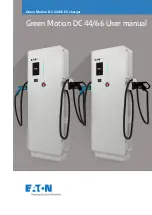
Express
®
EnCore™
Owner’s Manual
I.B. 1660
11
GLOSSARY
Wi-iQ
®
Device
This unit, permanently mounted on the battery, ensures that certain battery parameters can be
sent to the charger for the purposes of optimizing the charge and monitoring the charging and
discharging characteristics. The Wi-iQ
®
device is required when using the Fast Profile.
Charging Profile
The charging profile defines the rate of charge current over time. The charger adapts to the
battery’s age and level of discharge. Controlling the overcharge coefficient, whatever the
battery’s discharge level, reduces the amount of electricity consumed.
Cold Storage Profile
This is a charging profile that allows the configuration of the charger for use with batteries in cold
storage application. The profile is an IEI (constant current, constant voltage, constant current)
type with a number of user configurable parameters.
Equalization Charging
Equalization charging, performed after normal charging, balances the electrolyte densities in the
battery’s cells.
Fast Profile
This charging profile is an IEI charging profile designed to charge batteries at rates between 40-
50% of their rated amp hour capacity. Requires Wi-iQ device on battery.
IONIC™ Profile
The IONIC™ charging profile consistently diagnoses the battery throughout the recharge and
adjusts the charging profile to effectively charge the battery. The intelligent diagnostic sampling
provides more rapid optimized charging of flooded cell batteries subject to very high demands.
The short current pulses stimulate gas formation in the active material, causing sulfuric acid to
be distributed outside the plates and balances out differences in density, homogenizing the
electrolyte across the surface of the plates.
Opportunity Profile
This charging profile is used when opportunity charging is desired. It includes a start rate of up
to 25% of the battery’s 6-hour rated amp hour capacity and requires an equalize charge
performed once a week. The weekly equalize charge can be programmed to run automatically.
Operation
During opportunity charging the user should charge the battery during breaks, lunch or
any available time during the work day. The Opportunity Profile allows the battery to be
safely charged while it is kept in a partial state of charge between 20% and 80% of the
6-hour rated capacity during the work week. Sufficient time should be scheduled after
the weekly equalize charge to check and maintain electrolyte levels and allow the
battery to cool to ambient temperatures.













































